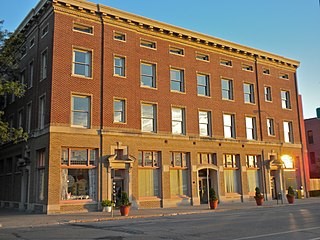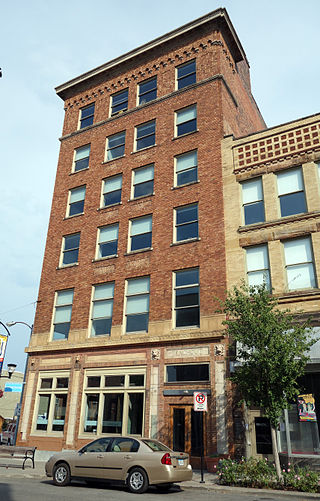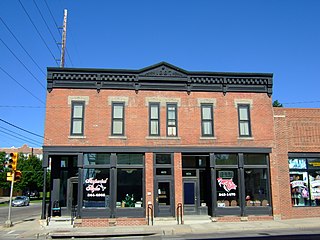
Historic East Village is a commercial and residential neighborhood in central Des Moines, Iowa, United States, directly east of the Downtown Des Moines area. The neighborhood is bounded by Interstate 235 on the north, the Des Moines River on the west and south, and East 14th Street on the east. It also sits adjacent to the Historic Court District, which sits west across the Des Moines River. Part of the East Village forms a nationally recognized historic district that was listed on the National Register of Historic Places in 2019.

The Des Moines County Court House located in Burlington, Iowa, United States, was built in 1940. It was listed on the National Register of Historic Places in 2003 as a part of the PWA-Era County Courthouses of Iowa Multiple Properties Submission. The courthouse is the fourth structure to house court functions and county administration.

The Des Moines City Hall is a government building in Des Moines, Iowa, built in 1909 and 1910. It was individually listed on the National Register of Historic Places on November 10, 1977 as the Municipal Building, and became a contributing property in the Civic Center Historic District in 1988. The building serves as the seat for the government of the city of Des Moines. Beginning April 7, 2016, City Hall offices were temporarily relocated while the building underwent renovation. The construction was necessary to install modern heating, cooling, and sprinkler systems while preserving the historic character of the building. The project was expected to take 18–24 months. During that time, City Hall was closed to the public, and City offices moved to other nearby locations. Between February 26, 2018 and April 9, 2018, city offices moved back to City Hall.

The Northwestern Hotel is a historic building located in the East Village of Des Moines, Iowa, United States. It was listed on the National Register of Historic Places in 1984. In 2017 it was included as a contributing property in the East Des Moines Industrial Historic District.

The Baker-Devotie-Hollingsworth Block is a historic building located in the East Village of Des Moines, Iowa, United States. The eastern two-thirds of the block was listed on the National Register of Historic Places in 1978 as the Studio Building. The western one-third was added to the National Register in 2008, and its name was changed at that time. In 2019 the entire building was included as a contributing property in the East Des Moines Commercial Historic District.

The Hohberger Building is a historic building located in the East Village of Des Moines, Iowa, United States. The building was built in 1895 and is one of the few remaining examples of a cast-iron column structure in the city. A dry goods store named Dockstader & Co. was the first retail establishment to occupy the building (1899–1915). The building stood empty for several years until it was renovated in 1999. The ground level of the building remains retail space and the upper floors are occupied by offices. It was individually listed on the National Register of Historic Places in 1978.In 2019 it was included as a contributing property in the East Des Moines Commercial Historic District.

The Teachout Building is a historic building located in the East Village of Des Moines, Iowa, United States. It was individually listed on the National Register of Historic Places in 1999. In 2019 the building was included as a contributing property in the East Des Moines Commercial Historic District.

The Wherry Block, also known as Wherry's Hall, Scruby Brothers Grocery, and Scruby's Grocery Store, is a historic building located in Des Moines, Iowa, United States.

The Sixth and Forest Historic District is located in Des Moines, Iowa, United States. It is a Victorian era suburban commercial district on the northeastern and northwestern corners of the junction of 6th and Forest Avenues, and originally contained six buildings. The buildings on the northeast corner have subsequently been torn down. The historic district has been listed on the National Register of Historic Places since 1996. It is a part of the Towards a Greater Des Moines MPS.

The West Ninth Streetcar Line Historic District is located in the north-central section of Des Moines, Iowa, United States. The focus of the district is West Ninth Street from University Avenue on the south to Hickman Road on the north, which had a street car line that ran on it. It has been listed on the National Register of Historic Places since 1998. It is part of the Towards a Greater Des Moines MPS.

The Des Moines Saddlery Company Building is a historic building located in downtown Des Moines, Iowa, United States. It was built in 1881 by J. Rubelman of Muscatine, Iowa. He choose to move his operation to Des Moines because of its location on two rivers and the 13 railroads that served the city. It was one of four saddlery firms in a two block area. Rubelman's company made saddles, harnesses and leather works for 20 years. In the years since it has housed a shoe maker, rubber company, stove manufacturer, glove company, the Krispy Kone Company and the Kaplan Hat Company. The later was also the name of the restaurant that was located on the first floor.

The Perry and Brainard Block, also known as the North Des Moines Town Hall, is a historic building located in Des Moines, Iowa, United States. The structure was built between 1888 and 1889 and the second floor served as the city hall for the suburb of North Des Moines. In the late 19th century Des Moines actively sought to annex its Victorian suburbs, with North Des Moines being the largest of these communities. This is the only known public building that has survived from the Annexation Movement era. The local government and community of North Des Moines debated annexation, not only of the municipalities, but of their schools as well. It was also the only community where the residents voted on the annexation issue, and this building also served as a polling place. The building served as the location of the celebration after the referendums passed in 1890. After its use as the city hall, the second floor became the lodge for the Ancient Order of United Workmen.

Hallett & Rawson was an architectural partnership in Iowa. George E. Hallett and Harry Rawson were partners. BBS Architects | Engineers is the continuing, successor firm; its archives hold plans of the original Hallett & Rawson firm. Works by the individual architects and the firm include a number that are listed on the National Register of Historic Places.

Youngerman Block is a three-story commercial building in downtown Des Moines, Iowa, incorporating Italianate architecture, with later alterations that introduced Art Deco detailing. Built in 1876, the Youngerman Block was designed by architect William Foster (1842-1909) for Conrad Youngerman.

The West Jefferson Street Historic District is five commercial blocks on the west side of downtown Burlington, Iowa, United States. It was listed on the National Register of Historic Places in 1982. In 2015 the area was included in the Downtown Commercial Historic District. West Jefferson Street was the main thoroughfare in the late 19th century and early 20th century through the Hawkeye Creek Valley. It led from the central business district along the Mississippi River to the Agency Road that headed westward out of town. The historic district is mostly made up of commercial buildings that range from single story structures to four story brick buildings, many of which have stone and terra cotta details. There is also a single frame building. A significant number of the structures are Italianate in style. The historic combined Fire and Police Station is also part of the district. At the time of its nomination there were 63 buildings in the district, of which 49 were contributing properties.

The Downtown Commercial Historic District encompasses most of the central business district of Burlington, Iowa, United States. It was listed on the National Register of Historic Places in 2015. The historic district includes 65 properties that were part of a 2012 to 2013 survey of the area. It also includes as contributing properties the buildings in the West Jefferson Street Historic District and three buildings in the Manufacturing and Wholesale Historic District that were previously listed on the National Register. All total there are 122 resources within the district, which includes 108 contributing and 14 non-contributing properties.

The Valley Junction-West Des Moines City Hall and Engine House is a historic building located in West Des Moines, Iowa, United States. Valley Junction was incorporated in 1893, and it was named for the junction of three lines of the Chicago, Rock Island and Pacific Railroad where it was located. This two-story brick building was constructed to house the community's city hall and fire station, even though the fire department would not be established until 1905. The fire station was located on the first floor, and the city hall was located on the second floor. It was located a block north of the train depot. An interurban railway connected the town to Des Moines, and its proximity to the Iowa coal fields contributed to its growth. By 1911 the town grew to be the second largest community in Polk County, and its name was changed to West Des Moines by 1940. The building was used for city hall until 1952. It was individually listed on the National Register of Historic Places in 1983. It was included as a contributing property in the Valley Junction Commercial Historic District in 2017.

The Flynn–Griffin Building, also known as the Flynn Block, Peoples' Savings Bank Building, and the Edna M. Griffin Building, is a historic building located in Des Moines, Iowa, United States. It was listed on the National Register of Historic Places in 2016.

The First National Bank of Davenport, also known as Brenton Bank and The Brenton, is a historic building located in central Davenport, Iowa, United States. It was added to the National Register of Historic Places in 2018. It is significant for its associations with the history of community planning and development, and as an important example of modernistic design.

The Iowa City Downtown Historic District is a nationally recognized historic district located in Iowa City, Iowa, United States. It was listed on the National Register of Historic Places in 2021. At the time of its nomination it consisted of 102 resources, which included 73 contributing buildings, one contributing site, one contributing object, 21 non-contributing buildings, and seven non-contributing objects. Eight buildings that were previously listed on the National Register are also included in the district. Iowa City's central business district developed adjacent to the Iowa Old Capitol Building and the main campus of the University of Iowa. This juxtaposition gives the area its energy with the overlap of university staff and students and the local community. The district was significantly altered in the 1970s by the city's urban renewal effort that brought about the Ped Mall, which transformed two blocks of College Street from Clinton Street to Linn Street and Dubuque Street from Burlington Street to Washington Street. It is the contributing site and the large planters/retaining walls that are original to the project are counted together as the contributing object. There are also several freestanding, limestone planters, five contemporary sculptures, and a playground area are the non-contributing objects.























